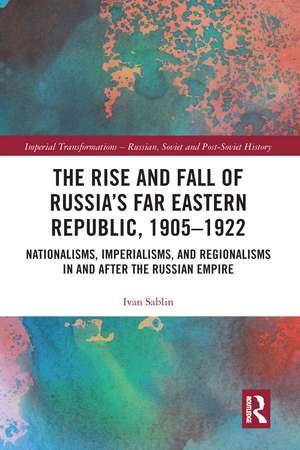The Rise and Fall of Russia's Far Eastern Republic, 1905–1922: Nationalisms, Imperialisms, and Regionalisms in and after the Russian Empire: Imperial Transformations – Russian, Soviet and Post-Soviet History
Autor Ivan Sablinen Limba Engleză Paperback – 30 iun 2020
Preț: 272.51 lei
Preț vechi: 334.10 lei
-18% Nou
Puncte Express: 409
Preț estimativ în valută:
52.14€ • 54.44$ • 43.16£
52.14€ • 54.44$ • 43.16£
Carte tipărită la comandă
Livrare economică 04-18 aprilie
Preluare comenzi: 021 569.72.76
Specificații
ISBN-13: 9780367588458
ISBN-10: 0367588455
Pagini: 312
Ilustrații: 40
Dimensiuni: 156 x 234 x 32 mm
Greutate: 0.45 kg
Ediția:1
Editura: Taylor & Francis
Colecția Routledge
Seria Imperial Transformations – Russian, Soviet and Post-Soviet History
Locul publicării:Oxford, United Kingdom
ISBN-10: 0367588455
Pagini: 312
Ilustrații: 40
Dimensiuni: 156 x 234 x 32 mm
Greutate: 0.45 kg
Ediția:1
Editura: Taylor & Francis
Colecția Routledge
Seria Imperial Transformations – Russian, Soviet and Post-Soviet History
Locul publicării:Oxford, United Kingdom
Cuprins
Introduction, Chapter 1: Left-liberal nationalism and self-organization east of Baikal, 1905–1916, Chapter 2: Post-imperial particularisms in the Russian Far East, 1917–1919, Chapter 3: Nationalisms and the making of the Far Eastern Republic, 1920, Chapter 4: The Far Eastern Republic and the Priamur State Formation, 1921, Chapter 5: Competing nationalisms and Sovietization in the Russian Far East, 1922, Conclusion
Notă biografică
Ivan Sablin is a Research Group Leader in the Department of History, University of Heidelberg, Germany
Recenzii
The Rise and Fall of Russia’s Far Eastern Republic, 1905–1922 by Ivan Sablin was awarded an honorary mention for 2018 by the board of Ab Imperio for the best study in new imperial history and history of diversity in Northern Eurasia, up to the late twentieth century.
Descriere
The Russian Far East was a remarkably fluid region in the period leading up to, during, and after the Russian Revolution. This book charts developments in the region, examines the interplay of the various forces, and explains how a Bolshevik version of state-centered nationalism prevailed.


